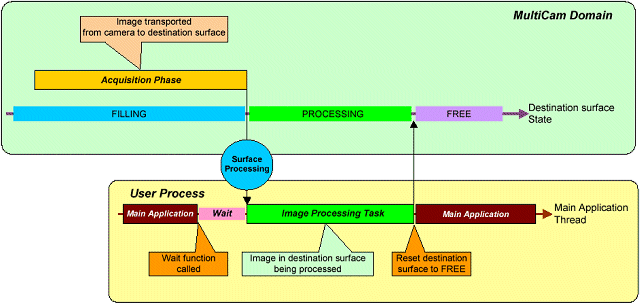Waiting Signaling
The waiting mechanism implies an event being waited for. The following description uses the Surface Processing signal as an example of the waited event.
The Surface Processing signal occurs when a transfer phase terminates. It is issued by a channel to indicate that the destination memory surface has been filled with an image coming from the source camera, and that this surface is available for image processing.
The main application thread has to wait for a specified event to occurs. Subsequently, the image processing task is performed.

Waiting mechanism
The MultiCam wait function is McWaitSignal.
Waiting Signaling Information
The main application thread can be forced to wait for a specific MultiCam signal. The signal should be enabled with the SignalEnable parameter.
Only one signal can be waited for in a given thread at a given time.
The dedicated MultiCam function to control the waiting mechanism is called McWaitSignal.
If the expected signal does not occur within the specified timeout, the function returns MC_TIMEOUT.
When waiting for the Surface Processing signal, it is the application responsibility to reset the SurfaceState parameter of the PROCESSING surface to FREE when done. Failure to do so will prevent the surface from being used by subsequent acquisitions.
If the waiting signaling mechanism is used, the callback signaling mechanism cannot be used. However, the advanced signaling mechanism can be used as long as it is not used for the particular event involved in the waiting function.
